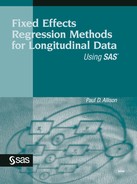1.4. Why Are These Methods Called "Fixed Effects"?
The name "fixed effects" is a source of considerable confusion. As we shall see, the basic idea is very simple. Consider the linear model
where the i subscript refers to different persons and j refers to different measurements within persons—i.e., the same variable measured at different points in time. In conventional linear model terminology, β1 xij is described as a fixed effect because the xij terms are all measured values and β1 is a fixed parameter. On the other hand, εij is regarded as a random variable with a probability distribution, and we make certain assumptions about this distribution. For example, we might assume that εij has a normal distribution with mean 0 and variance σ2. So the typical linear model has both fixed components and random components.
What about the term αi, which we use to represent all stable characteristics of persons? Here we have an important choice between treating αi as either fixed or random. Some methods, such as the so-called mixed models estimated by PROC MIXED, treat αi as a random variable with a specified probability distribution (usually normal, homoscedastic, and independent of all measured variables). In the econometric literature, these are called random effects models. In fixed effects models, however, the αi term is treated as a set of fixed parameters, which may either be estimated directly or conditioned out of the estimation process. Hence the name, "fixed effects."
Which is better, fixed effects or random effects? That depends on your objectives. In the preceding section, I already described the advantages and disadvantages of fixed effects methods. The advantages and disadvantages of random effects methods are the mirror image. Random effects methods do not control for unmeasured, stable characteristics of the individuals. That's because the αi terms are virtually always assumed to be uncorrelated with the measured variables that are included in the model. On the other hand, with random effects you can estimate the effects of stable covariates such as race and gender. And because they use variation both within and between individuals, random effects methods typically have less sampling variability than fixed effects methods. Although the primary focus of this book is on fixed effects methods, I will often contrast those methods with alternative random effects approaches.
In my view, then, the decision to treat the between-person variation as fixed or random should depend largely on
whether it's important to control for unmeasured characteristics of individuals
whether it's important to estimate the effects of stable covariates
whether one can tolerate the substantial loss of information that comes from discarding the between-individual variation
In the literature on ANOVA and experimental design, however, the decision between fixed and random effects is often described in quite different terms. Consider the following characterization:
Common practice is to regard the treatment effects as fixed if those treatment levels used are the only ones about which inferences are sought . . . . If inferences are sought about a broader collection of treatment effects than those used in the experiment, or if the treatment levels are not selected purposefully . . ., it is common practice to regard the treatment effects as random (LaMotte 1983, pp. 138–139).
According to this view, it would nearly always make more sense to treat the between-person variation represented by αi as random, because then one can make inferences to broader populations than the sample in hand. But for the kinds of applications considered in this book, I believe that argument is mistaken, for two reasons. First, the purpose of including αi in the equation is usually not because we want to estimate or test hypotheses about the between-person effects. Instead, the goal is to estimate the coefficients of other variables while controlling for unmeasured covariates and adjusting for lack of independence among the multiple observations for each person. For these purposes, it's irrelevant whether inferences about αi can or cannot be generalized to larger populations. Second, fixed effects models are generally much less restrictive than random effects models, and thus these models are more likely to represent the data in a realistic way. In fact, for linear models it has been shown that random effects estimators are a special case of fixed effects estimators (Mundlak 1978).
